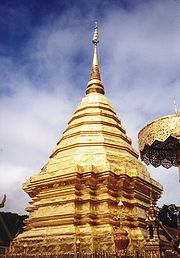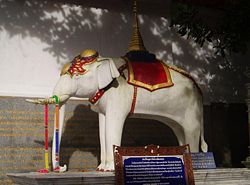
Wat Phrathat Doi Suthep
Encyclopedia

Theravada
Theravada ; literally, "the Teaching of the Elders" or "the Ancient Teaching", is the oldest surviving Buddhist school. It was founded in India...
Buddhist temple in Chiang Mai Province
Chiang Mai Province
Chiang Mai is the second-largest province of Thailand, located in the north of the country. Neighboring provinces are Chiang Rai, Lampang, Lamphun, Tak, and Mae Hong Son. In the north it borders Shan State of Burma...
, Thailand
Thailand
Thailand , officially the Kingdom of Thailand , formerly known as Siam , is a country located at the centre of the Indochina peninsula and Southeast Asia. It is bordered to the north by Burma and Laos, to the east by Laos and Cambodia, to the south by the Gulf of Thailand and Malaysia, and to the...
. The temple is often referred to as "Doi Suthep
Doi Suthep
Doi Suthep , is a mountain located in Chiang Mai Province, Thailand.-Description: Doi Suthep is one of the twin peaks of a granite mountain located west of Chiang Mai, the other peak is known as Doi Pui and is slightly taller .Doi Suthep is located 15 km away from Chiang Mai city centre.Most...
" although this is actually the name of the mountain it is located on. The temple is located 15 km from the city of Chiang Mai
Chiang Mai
Chiang Mai sometimes written as "Chiengmai" or "Chiangmai", is the largest and most culturally significant city in northern Thailand. It is the capital of Chiang Mai Province , a former capital of the Kingdom of Lanna and was the tributary Kingdom of Chiang Mai from 1774 until 1939. It is...
and is a sacred site to many Thai people
Thai people
The Thai people, or Siamese, are the main ethnic group of Thailand and are part of the larger Tai ethnolinguistic peoples found in Thailand and adjacent countries in Southeast Asia as well as southern China. Their language is the Thai language, which is classified as part of the Kradai family of...
. From the temple impressive views of Chiang Mai can be seen and it remains a popular destination of foreign visitors.
History
The original founding of the temple remains a legend and there are a few varied versions. The temple is said to have been founded in 1383 when the first chediStupa
A stupa is a mound-like structure containing Buddhist relics, typically the remains of Buddha, used by Buddhists as a place of worship....
was built. Over time the temple has expanded, and been made to look more extravagant with many more holy shrines added. A road to the temple was first built in 1935.
White Elephant Legend

Sukhothai kingdom
The Sukhothai Kingdom ) was an early kingdom in the area around the city Sukhothai, in north central Thailand. The Kingdom existed from 1238 till 1438...
had a dream; in this vision he was told to go to Pang Cha and look for a relic. Sumanathera ventured to Pang Cha and is said to have found a bone, which many claim was Buddha
Gautama Buddha
Siddhārtha Gautama was a spiritual teacher from the Indian subcontinent, on whose teachings Buddhism was founded. In most Buddhist traditions, he is regarded as the Supreme Buddha Siddhārtha Gautama (Sanskrit: सिद्धार्थ गौतम; Pali: Siddhattha Gotama) was a spiritual teacher from the Indian...
's shoulder bone. The relic displayed magical powers; it glowed, it was able to vanish, it could move itself and replicate itself. Sumanathera took the relic to King Dharmmaraja who ruled the Sukhothai.
The eager Dharmmaraja made offerings and hosted a ceremony when Sumanathera arrived. However the relic displayed no abnormal characteristics, and the king, doubtful of the relic's authenticity, told Sumanathera to keep it.
However, King Nu Naone of the Lanna Kingdom heard of the relic and offered the monk to take it to him instead. In 1368 with Dharmmaraja's permission, Sumanathera took the relic to what is now Lamphun
Lamphun
Lamphun is a town in northern Thailand, capital of Lamphun Province. It covers the whole tambon Nai Mueang of Mueang Lamphun district...
, in northern Thailand. The relic apparently split in two, one piece was the same size, the other was smaller than the original. The smaller piece of the relic was enshrined at a temple in Suandok. The other piece was placed by the King on the back of a white elephant
White elephant
A white elephant is an idiom for a valuable but burdensome possession of which its owner cannot dispose and whose cost is out of proportion to its usefulness or worth...
which was released in the jungle. The elephant is said to have climbed up Doi Suthep, at the time called Doi Aoy Chang (Sugar Elephant Mountain), trumpeted three times before dying at the site. It was interpreted as a sign and King Nu Naone ordered the construction of a temple at the site.
Wat Doi Suthep
The wat can be reached by road from Chiang MaiChiang Mai
Chiang Mai sometimes written as "Chiengmai" or "Chiangmai", is the largest and most culturally significant city in northern Thailand. It is the capital of Chiang Mai Province , a former capital of the Kingdom of Lanna and was the tributary Kingdom of Chiang Mai from 1774 until 1939. It is...
. From the car park, at the temple base visitors can climb 309 steps for free to reach the pagodas or there is a tram. Entry to the temple on the tram costs 30 Thai baht
Thai baht
The baht is the currency of Thailand. It is subdivided into 100 satang . The issuance of currency is the responsibility of the Bank of Thailand.-History:The baht, like the pound, originated from a traditional unit of mass...
for foreigners (or 50 baht if you would like a two-way tram ticket included) and is free for Thai nationals.
Once inside the temple grounds; visitors must take off their shoes. Visitors must be appropriately dressed. The original copper plated chedi is the most holy area of the temple grounds. Within the site are pagodas, statues, bells and shrines. Aspects of the Wat draw from both Buddhism
Buddhism
Buddhism is a religion and philosophy encompassing a variety of traditions, beliefs and practices, largely based on teachings attributed to Siddhartha Gautama, commonly known as the Buddha . The Buddha lived and taught in the northeastern Indian subcontinent some time between the 6th and 4th...
and Hinduism
Hinduism
Hinduism is the predominant and indigenous religious tradition of the Indian Subcontinent. Hinduism is known to its followers as , amongst many other expressions...
. There is a model of the Emerald Buddha
Emerald Buddha
The Emerald Buddha is the palladium of the Kingdom of Thailand, a figurine of the sitting Buddha, made of green jadeite , clothed in gold, and about 45 cm tall...
and a statue of the Hindu God Ganesh. Views of Chiang Mai can be seen on the other side of the temple.
See also
- Doi SuthepDoi SuthepDoi Suthep , is a mountain located in Chiang Mai Province, Thailand.-Description: Doi Suthep is one of the twin peaks of a granite mountain located west of Chiang Mai, the other peak is known as Doi Pui and is slightly taller .Doi Suthep is located 15 km away from Chiang Mai city centre.Most...
- Buddhist temples in Thailand
- Doi Suthep National Park

